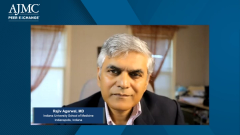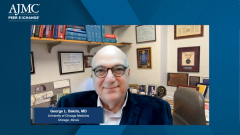
Clinical and Economic Burden of Chronic Kidney Disease
Financial and clinical concerns surrounding the burden of chronic kidney disease progression, as well as social determinants that factor into managing the condition in the community.
Episodes in this series

Neil B. Minkoff, MD: How common is this? There are wide estimates of how common diabetic kidney disease or chronic kidney disease [CKD] is. Dr Wright, could you help us understand just how common this is in a general practice and not just in a specialized practice like yourself?
Eugene Wright Jr., MD: That’s a great question because it’s often overlooked. Many primary care clinicians are very busy, and we don’t see things that aren’t obvious to us right away. But the prevalence or how common this is in the general population is about 40% of patients with type 2 diabetes will have some level of CKD. Oftentimes the extension of that is it goes unrecognized until it gets to be advanced, and at that point we’re referring the patient on. One of the challenges that we have is earlier, better recognition of CKD, because as George and Rajiv have said, we want to catch this early so we can slow the progression.
Neil B. Minkoff, MD: Let me ask this. As you guys know, I was at a payer organization for a number of years, and I would guess that a lot of these patients don’t come to the attention of the payer community until they’re quite advanced, like patients who are starting to think about dialysis or getting on transplant lists, because a lot of the things that we’re talking about seem—this is going to sound mean—reasonably routine. You’re putting patients on medications, they tend to be older medications, you’re seeing them frequently, you’re advising sugar control, lipid control, and so on, which many of us advise for many types of patients.
What do you see in terms of how these patients interact with the health care system, and how their resource utilization goes up? So not just when they get to the stage where they’re looking at kidney disease leading to dialysis, but prior to that. Where are they interacting with the system? I’ll open that up to everybody, because it’s something our payer community needs to have a better understanding of.
Rajiv Agarwal, MD: Neil, I can tell you a little about that because there was a large study done using the entire VA [Veterans Affairs] system. It was done by good folks in Michigan. They looked at the health care costs associated with chronic kidney disease to the VA. It was mind boggling. Forty percent of the health care costs in the VA was in patients who had chronic kidney disease. They were just blown away because they thought it was cancers and cardiovascular disease. We often equate chronic kidney disease with going on dialysis, but it’s really a cardiovascular disease, because a lot of these patients come in with strokes, MI [myocardial infarction], but most importantly, hospitalization for heart failure, which is a big deal in these people.
Also, people who have chronic kidney disease have something that nobody really talks about, the social issues. These patients have enormous players of social determinants of health: homelessness, lack of access to food, food insecurity, medication issues, and transportation issues. These are big factors playing in, and they get aggravated as the kidney disease advances. Somebody has said that your zip code is more important than the genetic code. The social determinants are really important here.
If we’re looking at patients with chronic kidney disease, we can’t just look at a KDIGO [Kidney Disease: Improving Global Outcomes] heat map and say we’ve got the stage and GFR [glomerular filtration rate]. We have to look deeper and at the other factors that might be playing important roles and leading them to utilize more health care resources, as you just suggested.
Eugene Wright Jr., MD: I just wanted to amplify that access to care across zip codes and social determinants of health really are a large factor driving what I see in primary care, having spent some of my career working in a free clinic. A lot of these patients don’t have access to care. And even when we can get the access for them, the awareness on the part of the health care practitioners to be able to intervene early and consistently is somewhat less than optimal.
George L. Bakris, MD: Let me put icing on that cake, Neil. Taking what Rajiv and Gene just said, there’s no question. This is so obvious to me that I didn’t even mention it. But when I’m finishing explaining the heat map to the patient, the next conversation is about resources. The next conversation is about price of the drugs. That’s happening, that’s a real thing. I’m so used to it, I don’t even put it in the equation. But it’s a critically important part. As one of my colleagues has said, it takes a village to treat diabetes.
Neil B. Minkoff, MD: Let me ask you a question. This is open to the whole group. Do you think the experience that you read about in the VA translates to organizations like Duke University, the University of Chicago, or Indiana University, where there’s probably a different level of insurance and so on, or do you feel that’s consistent throughout?
George L. Bakris, MD: It’s consistent if you control for level of insurance. So yes, I have patients who have excellent insurance, and there it becomes a nonissue. We don’t have that discussion very much. But if you control for level of insurance of VA or below, that discussion is happening 100% of the time.
Transcript edited for clarity.
Newsletter
Stay ahead of policy, cost, and value—subscribe to AJMC for expert insights at the intersection of clinical care and health economics.







































